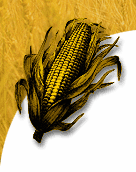

  |
|
|
Puzzle of corn's origins coming together
(Thursday, April 8, 2004 -- CropChoice news) -- EurekAlert!, Duke University, 07/02/04:
The scientific puzzle pieces are fitting together to form a definitive picture of the origin of corn, says a Duke University plant geneticist who has proposed that the world's most important food crop originated in an ancient cross between two grasses.
Mary Eubanks described the latest evidence that corn, or maize, originated as a cross between teosinte and gamagrass, or Tripsacum , in a talk Friday, April 2, 2004, at a symposium on maize held at the annual meeting of the Society for American Archaeology (www.saa.org ) in Montreal. Her research is supported by the National Science Foundation and the North Carolina Biotechnology Center.
Eubanks, an adjunct professor of biology, has developed evidence that modern corn, scientific name Zea mays, did not evolve solely from a Central American grass known as teosinte -- traditionally the most widely held theory. Rather, her experiments clearly demonstrate that corn arose from a serendipitously viable cross between teosinte and gamagrass.
Eubanks emphasized in an interview that her research has confirmed that teosinte was indeed one of corn's ancestors, and that gamagrass was a critical genetic contributor. She contrasts her evidence with the former, highly controversial theory of the late biologist Paul Mangelsdorf, who espoused that teosinte was an offshoot of a cross between corn and Tripsacum rather than an ancestor of corn. "My hypothesis confirms that teosinte is an ancestor of maize, and that key genes were also contributed by gamagrass," she said. In her talk, Eubanks displayed examples of her crosses between species of teosinte and gamagrass that exhibit the evolution from the tiny spikes of teosinte seeds to the early versions of corn ears.
New evidence from other researchers that maize evolved very rapidly, perhaps over only a century, supports such a theory, said Eubanks. Rather than the long, slow progressive evolution from teosinte into maize, a fertile cross between teosinte and gamagrass could have relatively quickly yielded early versions of maize. In her talk, Eubanks displayed archaeological specimens of corn alongside matching segregates from experimental crosses between teosinte and gamagrass.
Eubanks also discussed her comparative DNA fingerprinting studies of teosinte and Tripsacum taxa, along with primitive popcorns from Mexico and South America. Those analyses of over a hundred genes in the taxa revealed that some 20 percent of the versions, called alleles, of specific genes found in maize are found only in Tripsacum . And, about 36 percent of the alleles in maize were shared uniquely with teosinte.
"These findings are by no means conclusive," said Eubanks. "We need to do a lot more sampling of the genetic diversity in different teosinte and Tripsacum species to further test this finding. But certainly, the preliminary evidence from this study supports the hypothesis that Tripsacum introgression could have been the energizing factor for the mutations that humans then selected to derive domesticated maize."
In such selections, theorized Eubanks, early humans would have selected -- from the wide range of plants that would result from such crosses -- those that had the most numerous and accessible seeds. Eventually, such selection would have resulted in the cob-like structure of today's corn, she said.
Understanding the genetic origins of corn -- now the world's single largest food crop-- is important both for production of new varieties and for preserving corn's genetic heritage, said Eubanks.
"Because the crosses between teosinte and gamagrass bridge the sterility barrier between maize and Tripsacum , I'm now moving genes from gamagrass into corn," she said. "And we have developed drought-resistant and insect-resistant corn using conventional plant breeding methods."
For example, according to Eubanks, who is working with a commercial seed producer, test crops of some new hybrids have shown strong resistance to the billion-dollar bugs corn rootworm and European corn borer, along with corn earworm, another problematic corn pest.
"Understanding the genetic origins of corn and how people historically used corn could offer valuable insights for application to sustainable agriculture today," she said. "And finally, the gene pool underlying corn is part of our heritage that must be preserved if we are to retain the ability to solve agricultural problems such as new pests or the need for new farming methods."
Also, she noted, the scientific emphasis on corn is particularly timely because of recent findings that genetically altered corn is contaminating the native land races of maize and its wild relative teosinte currently in Mexico. This alteration of the natural gene pools of these genetic resources could have the effect of reducing the diversity of corn varieties, and compromise the ability to use those varieties as the basis for new crop strains.
According to Eubanks, the new drought and pest-resistant hybrids she and her colleagues have developed will undergo field tests this summer in the Midwest, followed by yield trials in winter nurseries, more field tests in the Midwest in 2005, and marketing seed in 2006.
Source: http://www.eurekalert.org/pub_releases/2004-04/du-poc033004.php | |